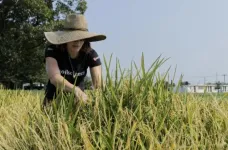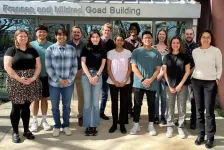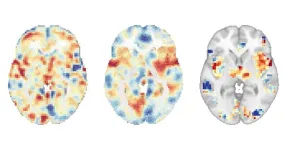(Press-News.org) Rice and spinach are staples for babies’ and young children’s diets, but toxic metals and metalloids found in those foods can cause severe health impacts.
In particular, heavy metals such as cadmium, lead, mercury, and metalloid arsenic could delay brain development in babies and young children.
In new research published in the academic journal Environmental Geochemistry and Health, University of Delaware scientists have found that flooded rice fields tend to contain higher amounts of arsenic and lower amounts of cadmium. The drier those rice fields are, the lower the amounts of arsenic and the higher the amounts of cadmium. However, the higher cadmium is lower than the existing threshold for adverse health effects.
The findings could help establish a course of action for decreasing the levels of these contaminants in foods typically eaten by infants and children. Earlier this year, the U.S. Food and Drug Administration issued draft guidance for the amount of lead allowed in baby foods. It’s on the verge of setting new regulations for the threshold of arsenic, cadmium and mercury that can be allowed in infant food as part of its Closer to Zero Action Plan.
Flooding rice fields
Crops such as corn, soybeans and wheat are grown in soils that are not very wet. So farmers water them to make sure the plants get the nutrients they need to grow, but never enough to fully flood them.
In contrast, rice is often grown in very wet, flooded soils. Oxygen that would normally reside in tiny pores in the soil gets lost very quickly and is replaced by water. The limited oxygen shifts the microorganisms in the soil, and those microorganisms start breathing with iron oxide minerals that give the soil a rusty orange color.
“Arsenic likes to stick really tightly onto those iron oxides,” said Angelia Seyfferth, a UD soil biogeochemist and professor in the Department of Plant and Soil Sciences, and a co-author of the research. “When the iron oxides are used by these organisms to breathe, they go from a solid mineral to a solution phase. You essentially dissolve them, and when you dissolve them, the arsenic that’s stuck onto them goes into the water.”
Seyfferth said that once the arsenic is in the water, it can easily be absorbed by the rice roots and transported into the grain.
Seyfferth and research associate Matt Limmer grew rice in 18 small fields on the UD Newark Farm, exposing the rice paddies to different flooded and wet conditions.
“We were hoping to find an optimal irrigation management that minimized both arsenic and cadmium simultaneously,” Limmer said, “but we didn't find one in this soil.”
Once they harvested the grain and analyzed the amount of arsenic and cadmium in it, the researchers instead found that the more flooded the field, the more arsenic and less cadmium accumulated in the rice. By contrast, the drier the field, the more cadmium and less arsenic accumulated.
“But, even under those drier conditions when there was more cadmium, the concentrations of cadmium in the grain were not of concern for human health,” Seyfferth said.
When the rice fields were flooded, and arsenic was taken up, the researchers noticed methanogenesis happening, which is when organisms in the soil produce the potent greenhouse gas methane and emit it into the atmosphere. Meanwhile, the excess water reduced sulfate in the soil to sulfide, causing cadmium to precipitate out with the sulfide.
When they dried the soil out, the researchers decreased the levels of arsenic and methane. Sulfide in the soil was oxidized and became sulfate, which is no longer a solid phase, allowing cadmium to easily filter through and escape into the plant easily.
“By drying out the soil, we’re sort of putting the brakes on the microorganisms that breathe with iron oxides and with arsenic,” Seyfferth said. “Then we actually increase the amount of cadmium because we oxidize the sulfide to sulfate. When it becomes sulfate, it’s no longer a solid phase with the cadmium, and the cadmium can then be free.”
Drying the soil out introduced oxygen into the soil pores, Seyfferth said, which slowed down the microorganisms that dissolve iron oxides and create methane and changed the chemistry.
“Once you introduce oxygen, the iron oxides that dissolved are solid again,” Seyfferth said. “They’re kind of like a Brita filter. The arsenic sticks onto the iron oxides and it’s not in the water, so the plant roots can’t really get it.”
What they found — one metal or metalloid increasing with the other decreasing depending on the level of moisture in the soil — presents a bit of a puzzle.
“There’s a challenge,” Seyfferth said. “It basically resides in what is this magic number or magic water status in the soil to try to minimize both of them. There really isn’t one that is universal across all soils.”
Through a U.S. Department of Agriculture National Institute of Food and Agriculture research grant, the researchers are studying arsenic in rice through some field work in Arkansas. They’ll work directly with farmers to develop tools to help them manage water flooding their rice paddies.
Meanwhile, the FDA could release new regulations for arsenic and cadmium in infant food by the end of this year, part of its aforementioned Closer to Zero Action Plan. The agency has spent some time researching the effects of arsenic and cadmium and two other toxins, mercury and lead, on child development. The FDA has also been evaluating new technologies or interventions that could stymie exposure to these toxins.
“Our work could hopefully help shape policy,” Seyfferth said.
Members of the Seyfferth Lab (Matt Limmer, Angelia Seyfferth, and graduate students Bekah Hanrahand and Frank Linam) harvest rice in the UD RICE Facility.
Involving farmers
UD researchers have also found, through a review paper in the academic journal GeoHealth, that producers are willing to take any action needed to reduce levels of metals in their crops, but they need incentives, testing and education in order to do so.
This was the case specifically for the spinach industry in five states — producers, packers, processors, and marketers- whom the researchers interviewed. Spinach can contain amounts of cadmium and lead that it absorbs through the soil.
“It’s really important to get stakeholder feedback to see what's feasible for farmers,” Seyfferth said, “and that it wouldn't be a big burden to something that they already do, or changing a practice that they're doing, that they have to do to meet some other standard, like a different food safety standard.”
The researchers explored interactions between plants with metals and metalloids, comparing and contrasting how cadmium and lead move through the soils and affect leafy greens. They also offer solutions for farmers to decrease the amount of metals and metalloids in the foods they grow.
“Farmers are often working on very thin margins for something like spinach,” Seyfferth said. “If the regulatory bodies made it really hard to achieve a certain level of cadmium or lead, they might just switch and grow something else.”
Complicating that, one challenge with cadmium in spinach is that water is chlorinated to disinfect spinach. But adding chloride actually makes it easier for cadmium to infiltrate a plant’s roots, which translocates it into the leafy green tissues.
“We might be making the cadmium problem worse by using chlorinated irrigation water for leafy greens,” Seyfferth said. “Maybe we should think about alternative ways to disinfect irrigation water that doesn’t involve chloride.”
Seyfferth said one solution to help decrease the levels of toxic metals and metalloids in foods is offering subsidies to farmers to do certain strategies to reduce those levels on their own. Cadmium, which can build up in spinach leaves, could be reduced by making soils less acidic and washing spinach leaves after harvest. Lead is harder to remove, but washing spinach leaves with lemon juice extract could remove up to 26 percent of the lead in the leaves, the researchers say.
“The solutions are not a blanket solution,” Seyfferth said. “They’re not for all soils. They would have to be really site-specific.”
Limmer and Seyfferth said more research is needed to find an optimal irrigation strategy that lowers levels of both arsenic and cadmium in rice.
“Similar experiments need to be done in a variety of soils,” Limmer said, “ideally under different field conditions.”
As the U.S. waits for the FDA’s draft regulations on the allowable threshold of arsenic, cadmium and mercury in baby food, Seyfferth said she would like to see the federal government redo a study last done in the 1980s. The FDA, U.S. Department of Agriculture and the U.S. Environmental Protection Agency analyzed paired soils and plants in agricultural fields across the U.S. to get an idea of the concentration of metals and metalloids in those plants and soils.
“Since then, there’s a lot more spinach being grown now and being grown in areas where it wasn’t grown before,” Seyfferth said. “Some of those soils are much higher in cadmium. My push would be to redo this survey.”
About the funding
The review article, “Mitigating Toxic Metal Exposure Through Leafy Greens: A Comprehensive Review Contrasting Cadmium and Lead in Spinach,” is published in the journal GeoHealth. Its authors are University of Delaware’s Angelia L. Seyfferth and Matt A. Limmer, Benjamin R. K. Runkle of University of Arkansas, and Rufus L. Chaney of Chaney Environmental LLC. The Institute for the Advancement of Food and Nutrition Sciences funded the work.
The research paper, “Controlling exposure to As and Cd from rice via irrigation management," was published in the journal Environmental Geochemistry and Health. It is authored by Matt A. Limmer and Angelia L. Seyfferth. The research was funded by the National Science Foundation.
END
Making baby food safer
Researchers hope new rice and spinach studies can inform food policy and curb the amount of toxic metals found in food
2024-09-06
ELSE PRESS RELEASES FROM THIS DATE:
Saline nasal drops reduce the duration of the common cold in young children by two days
2024-09-06
Using hypertonic saline nasal drops can reduce the length of the common cold in children by two days, according to a study that will be presented at the European Respiratory Society (ERS) Congress in Vienna, Austria [1]. They can also reduce the onward transmission of colds to family members.
The results of the ELVIS-Kids randomised controlled trial were presented by Professor Steve Cunningham from Child Life and Health, University of Edinburgh, UK.
He said: “Children have up to 10 to 12 upper respiratory tract infections, what we refer to as colds, per year, which ...
New RSV vaccine for older adults can result in individual and societal cost savings, benefits
2024-09-05
Vaccination against respiratory syncytial virus for adults over 60 is likely cost-effective by preventing illness, hospitalizations, lost quality of life and deaths, according to new research.
The study conducted by researchers at the University of Michigan and the U.S. Centers for Disease Control and Prevention and published in the journal Vaccine, evaluated newly approved RSV vaccines: Arexvy, manufactured by GSK, and Abrysvo, manufactured by Pfizer. The study did not include a third approved vaccine, Moderna's mRESVIA.
The vaccines are now available to adults 60 and older. The CDC recommends a single ...
Research news from the Ecological Society of America
2024-09-05
The Ecological Society of America (ESA) presents a roundup of seven research articles recently published across its esteemed journals. Widely recognized for fostering innovation and advancing ecological knowledge, ESA’s journals consistently feature illuminating and impactful studies. This compilation of papers explores the impact of rising temperatures on pathogens, dynamics of predatory seabirds and their penguin prey in Antarctica, factors determining the speed of coral reef recovery from disturbance and more.
From Ecology:
Some pathogens can’t ...
AI unlocks new path to personalized cancer treatments
2024-09-05
Researchers at Auburn University, in collaboration with scientists from the University of Basel and ETH Zurich, have made a groundbreaking advance in the fight against cancer. The team, led by Dr. Rafael Bernardi, Associate Professor of Biophysics in the Department of Physics, has developed a novel approach integrating artificial intelligence (AI) with molecular dynamics simulations and network analysis to enhance the prediction of binding sites on the PD-L1 protein. This breakthrough promises to accelerate the development ...
ResearchGate and Mary Ann Liebert, Inc. announce journal home partnership for open access journals
2024-09-05
ResearchGate, the professional network for researchers, and Mary Ann Liebert, Inc., a global media company dedicated to creating, curating, and delivering impactful peer-reviewed research and authoritative content services, are pleased to announce a new partnership through ResearchGate’s innovative Journal Home offering.
The partnership covers five Mary Ann Liebert, Inc. open access journals spanning the health and medical sciences. All backfile content and all new articles published with ...
Center for BrainHealth investigates the relationship between cannabis use, sleep and memory
2024-09-05
Dallas, September 5, 2024 – The growing legal use of recreational and medical cannabis has generated an increased concern for potential side effects from long-term use, particularly regarding problems with memory and sleep. Until now, the effect of cannabis use on sleep and on memory have only been studied separately. Research led by Francesca Filbey, PhD, from the Laboratory of Neuroimaging of Reward Dynamics at The University of Texas at Dallas’ Center for BrainHealth®, in collaboration with a team from the University of Amsterdam, aimed to fill this gap by testing how sleep impacts memory among cannabis users.
The study, “The ...
K-State researchers determine molecular interactions in plants
2024-09-05
Plant scientists have long known that phosphorus is a crucial component in plant growth. A major discovery by a K-State biologist and her lab is leading to a better understanding of how plants detect and use that resource — potentially leading to more efficient production of crops for food, fiber and fuel.
A team of researchers led by Kathrin Schrick, associate professor of biology, recently published this research in New Phytologist, a high-impact journal in the plant sciences.
Schrick's lab focused on a specific transcription factor that regulates gene expression during development. They discovered a new kind of molecular interaction between the ...
Study estimates home blood pressure devices don’t fit properly for more than 17 million US adults
2024-09-05
Over-the-counter blood pressure measuring devices offer a simple, affordable way for people to track hypertension at home, but the standard arm-size ranges for these devices won’t appropriately fit millions of U.S. consumers, according to a new study from researchers at the Johns Hopkins Bloomberg School of Public Health.
The researchers compared standard arm cuff size ranges for popular retail automatic blood pressure measuring devices to arm circumference data from U.S. government-sponsored national ...
Brain scans reveal that mindfulness meditation for pain is not a placebo
2024-09-05
Pain is a complex, multifaceted experience shaped by various factors beyond physical sensation, such as a person’s mindset and their expectations of pain. The placebo effect, the tendency for a person’s symptoms to improve in response to inactive treatment, is a well-known example of how expectations can significantly alter a person’s experience. Mindfulness meditation, which has been used for pain management in various cultures for centuries, has long been thought to work by activating the placebo response. However, scientists have now ...
Cancer research in space for life on earth
2024-09-05
WINSTON-SALEM, N.C. – September 5, 2024 — The Wake Forest Institute for Regenerative Medicine (WFIRM) is honored to announce its selection for a pioneering cancer research project that will take place aboard the International Space Station (ISS). The project, one of only five chosen through a competitive solicitation by the ISS National Lab in partnership with NASA, aims to explore the effects of microgravity on cancer development and treatment.
The project, led by Dr. Shay Soker, focuses on the use of organoids—miniature, simplified versions of organs grown in the lab from cells recovered from colorectal cancer patients. ...
LAST 30 PRESS RELEASES:
Numbers in our sights affect how we perceive space
SIMJ announces global collaborative book project in commemoration of its 75th anniversary
Air pollution exposure and birth weight
Obstructive sleep apnea risk and mental health conditions among older adults
How talking slows eye movements behind the wheel
The Ceramic Society of Japan’s Oxoate Ceramics Research Association launches new international book project
Heart-brain connection: international study reveals the role of the vagus nerve in keeping the heart young
Researchers identify Rb1 as a predictive biomarker for a new therapeutic strategy in some breast cancers
Survey reveals ethical gaps slowing AI adoption in pediatric surgery
Stimulant ADHD medications work differently than thought
AI overestimates how smart people are, according to HSE economists
HSE researchers create genome-wide map of quadruplexes
Scientists boost cell "powerhouses" to burn more calories
Automatic label checking: The missing step in making reliable medical AI
Low daily alcohol intake linked to 50% heightened mouth cancer risk in India
American Meteorological Society announces Rick Spinrad as 2026 President-Elect
Biomass-based carbon capture spotlighted in newly released global climate webinar recording
Illuminating invisible nano pollutants: advanced bioimaging tracks the full journey of emerging nanoscale contaminants in living systems
How does age affect recovery from spinal cord injury?
Novel AI tool offers prognosis for patients with head and neck cancer
Fathers’ microplastic exposure tied to their children’s metabolic problems
Research validates laboratory model for studying high-grade serous ovarian cancer
SIR 2026 delivers transformative breakthroughs in minimally invasive medicine to improve patient care
Stem Cell Reports most downloaded papers of 2025 highlight the breadth and impact of stem cell research
Oxford-led study estimates NHS spends around 3% of its primary and secondary care budget on the health impacts of heat and cold in England
A researcher’s long quest leads to a smart composite breakthrough
Urban wild bees act as “microbial sensors” of city health.
New study finds where you live affects recovery after a hip fracture
Forecasting the impact of fully automated vehicle adoption on US road traffic injuries
Alcohol-related hospitalizations from 2016 to 2022
[Press-News.org] Making baby food saferResearchers hope new rice and spinach studies can inform food policy and curb the amount of toxic metals found in food






